«previous pageGENERAL DESIGN CATEGORY
Honor Award
Museo del Acero Horno3, Monterrey, Mexico
Surfacedesign Inc.+ Harari arquitectos, San Francisco, CA
client: Museo Del Acero Horno3
Project Statement
A team of international designers collaborated to transform a decommissioned blast furnace and a brownfield site into a modern history museum dedicated to the region's rich history of steel production. Borrowing from materials endemic to the site, innovative landscape design weaves together with modern architecture to usher an old relic into the 21st century. Environmentally sensitive technologies - such as green roofs and a storm water collection system — offer a new approach to the landscape while respecting the original context.
Project Narrative
In 1986, the city of Monterrey, Mexico reclaimed an expansive 1.5 hectare brownfield site of a former steel production facility. Eleven years later, the site's decommissioned blast furnace has emerged as the Museo Del Acero Horno3, the Museum of Steel, which serves as a new focal point for the region. Located at the center of the modern Parque Fundidora, which receives more than two million visitors per year, the Museo Del Acero Horno3 narrates the story of steel production both to the generations who remember the history of the site and to younger visitors who may be unaware of the region's legacy.
The landscape for the Museo Del Acero Horno3 expresses the spirit of the site's former industrial glory and celebrates its position within the surrounding dramatic landscape. The overall landscape design emphasizes the physical profile of the 70-meter furnace structure while complementing the modern design of the new structures. The history of steel is an important narrative element throughout the site, and thus steel, much of it reclaimed from the site (such as the ore-embedded steel rails used to define the outdoor exhibit spaces) is used extensively to help define public plazas and delineate fountains and landscaped terraces. Large, free-formed steel objects and machinery unearthed during excavation were incorporated as stepping stones and other features. The design approach melds industrial site reclamation — and the adaptive re-use of on-site materials — with ecological restoration through the use of green technologies.
All of the storm water runoff within the site's boundaries is treated in a series of on-site treatment runnels. These surround the exhibition areas and reinterpret the former industrial canals that once moved steel production by-products within the site. Aquatic plants and wetland macrophytes bio-remediate and treat storm water before it enters an underground cistern where it is stored for dry season irrigation.
Two water features are integral to the narrative of the project, while helping to define and locate the public space adjacent to the museum. In the main esplanade, the steel plates that formerly clad the exterior of the main hall were repurposed into a stepped canal over which water cascades. The 200-meter-long feature alludes to the tracks used daily to train in the thousands of tons of raw materials that were off-loaded in this location, and serves as a visual connection to the rain garden in the landscape beyond. At the museum's entrance, the stepped canal culminates in the misting fountain, a grid of rocks visibly embedded with ore. This trompe l'oeil evokes the caustic heating process once used to extract ore, but instead of steam it generates a cooling mist that blows over the plaza - a pleasant surprise for visitors in Monterrey's hot and arid climate.
The use of green roofs (extensive and intensive) over the museum — which comprises the largest such roof system in Latin America — helps to reduce the visual impact of the new buildings. The existing furnace rises from this newly created ground plane. On the higher roof, a variety of drought-tolerant sedums have been arranged according to the structural roof patterns of the new architecture, and are contained by what appears to be a floating steel disk. A circular viewing deck allows visitors to take in the expanse of surrounding regional landscape, including the distant Sierra Madres, which are echoed in the roof's mounded shape. Below, Alfombra verde (green blanket) a less constrained meadow of tall grasses — an abstraction of the native landscape — creates a connection to the landscape's pre-industrial context both functioning as a bioremediation for degraded soil and increasing thermal benefits for the new structure.
Principals of sustainability are at the core of the landscape design of the Museo Del Acero Horno3. By thoughtfully repurposing found industrial artifacts and incorporating new green technologies that work in concert with the architecture and the greater landscape, the designers have created an outdoor exhibition space that interprets the area's historic uses while celebrating artistic opportunities for the future.
Project Resources
Surfacedesign Inc. + Harari Arquitectos:
Claudia Harari
James A. Lord
Silverio Sierra
Geoff Di Girolamo
Diego Rodríguez Renovales
Roderick R. Wyllie
Architect
Grimshaw, New York, NY
Associate Architects
Oficina de Arquitectura, S.A. de C.V
Client
Mr. Luis López, General Director, Museo Del Acero Horno3
Featured Products
Concrete
Cemex
Fountains, Installation, and Systems
Cepronsa
Green Roof System, Irrigation, and Sedum
Green Roof Systems de México
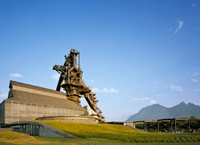
This view of the alfombra verde (green blanket) shows the integration of the new museum with the surrounding park, while ameliorating the visual connection to the larger regional landscape. (Photo: Paul Riveria / Archphoto)
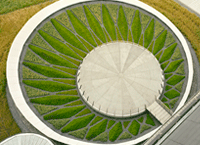
Aerial view of the largest green roof in Latin America. The planting pattern recalls the flame emitted from the historic blast furnace. Three drought tolerant sedum species are planted without irrigation. Each flowers at a different times providing a changing texture throughout the seasons. (Photo: Paul Riveria / Archphoto)
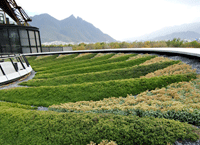
The viewing terrace overlooks the sedum-planted roof and out toward the regional landscape beyond. The planting pattern works in concert with the structure of the new museum roof and evokes the flame patterns of the steel burner's former use. (Photo: Abigail Guzman Tamex)
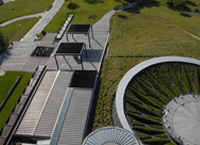
Entrance to the Museo del Acero Horno3. The landscape evokes its industrial past and regional landscape while creating a sustainable public space for its future. The plaza is composed of recycled concrete, steel and artifacts while new green technologies create the museums new skin. (Photo: James A. Lord)
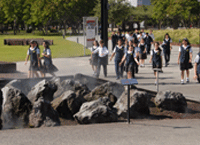
Set in a field of gravel, reclaimed ore-laden rocks comprise the misting water feature. This dramatic focal point evokes the historical steel manufacturing process while providing some welcome cooling effect in the arid climate. (Photo: James A. Lord)
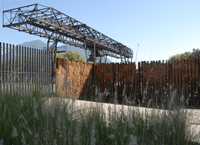
As seen from the treatment runnels — the outdoor exhibition space is defined by the repurposed ore embedded steel rails. The rails provide a rustic contrast to the refined offload crane beyond. (Photo: James A. Lord)
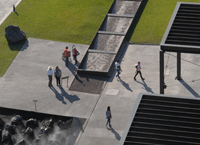
Recycled materials recovered from the site highlight it's history within a modern context. Sheets of found metal transformed into the fountain, while discarded slag remnants from the blast furnace smelting process become an interpretive steam fountain. (Photo: James A. Lord)
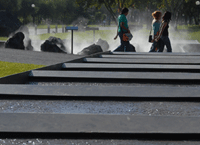
Sounds of rushing water in the new fountain have replaced the once heard clamor of trains moving raw materials to the furnace elevator. The fountain evokes this past dynamic movement across the site. (Photo: James A. Lord)
"This work represents a medley of great design inspirations that are applied so well throughout. The sedum pattern is spectacular, in dimension, color, and scale."
— 2009 Professional Awards Jury
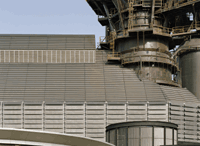
When entering the museum, the intensive green roof planting of native Love grass leads visitors to the primary entrance where landscape and architecture converge. (Photo: Paul Riveria / Archphoto)
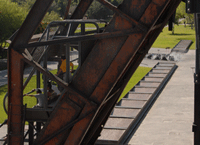
As viewed from the retrofitted furnace elevator, a 200 meter reverse flow fountain creates the optical illusion of water flowing uphill. Extending from the museum entrance, the fountain's path represents the historical flow of materials in and out of the blast furnace. (Photo: James A. Lord)
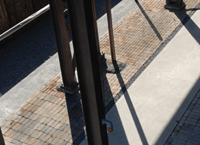
Blast furnace firebrick is repurposed into a paving material along a prominent pedestrian corridor within the museum and integrates with bands of reconstituted concrete and crushed ore aggregate to define pedestrian circulation and illustrate sustainability principles of the landscape. (Photo: James A. Lord)
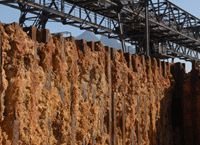
This detail of the metal rail fence highlights the steel fusion process and is an example of how raw materials result in eye-catching and irregular textures. (Photo: James A. Lord)
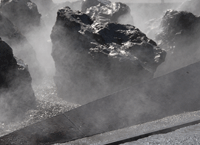
Detail of unearthed ore artifact featured in the 'caustic' mist of the trompe l'oeil entrance feature. (Photo: James A. Lord)
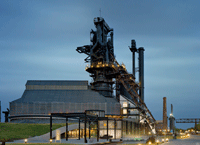
Evening view of the Museo del Acero Horno3. The steel in the canal water feature transforms into a cobalt blue glow. Lighting on the original furnace casts a dramatic silhouette on the site. (Photo: Paul Riveria / Archphoto)
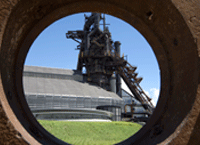
The visitors' first and last view of the Museo del Acero Horno3 introduces recycled industrial artifacts that serve as framing elements within the landscape. (Photo: Abigail Guzman Tamex)



